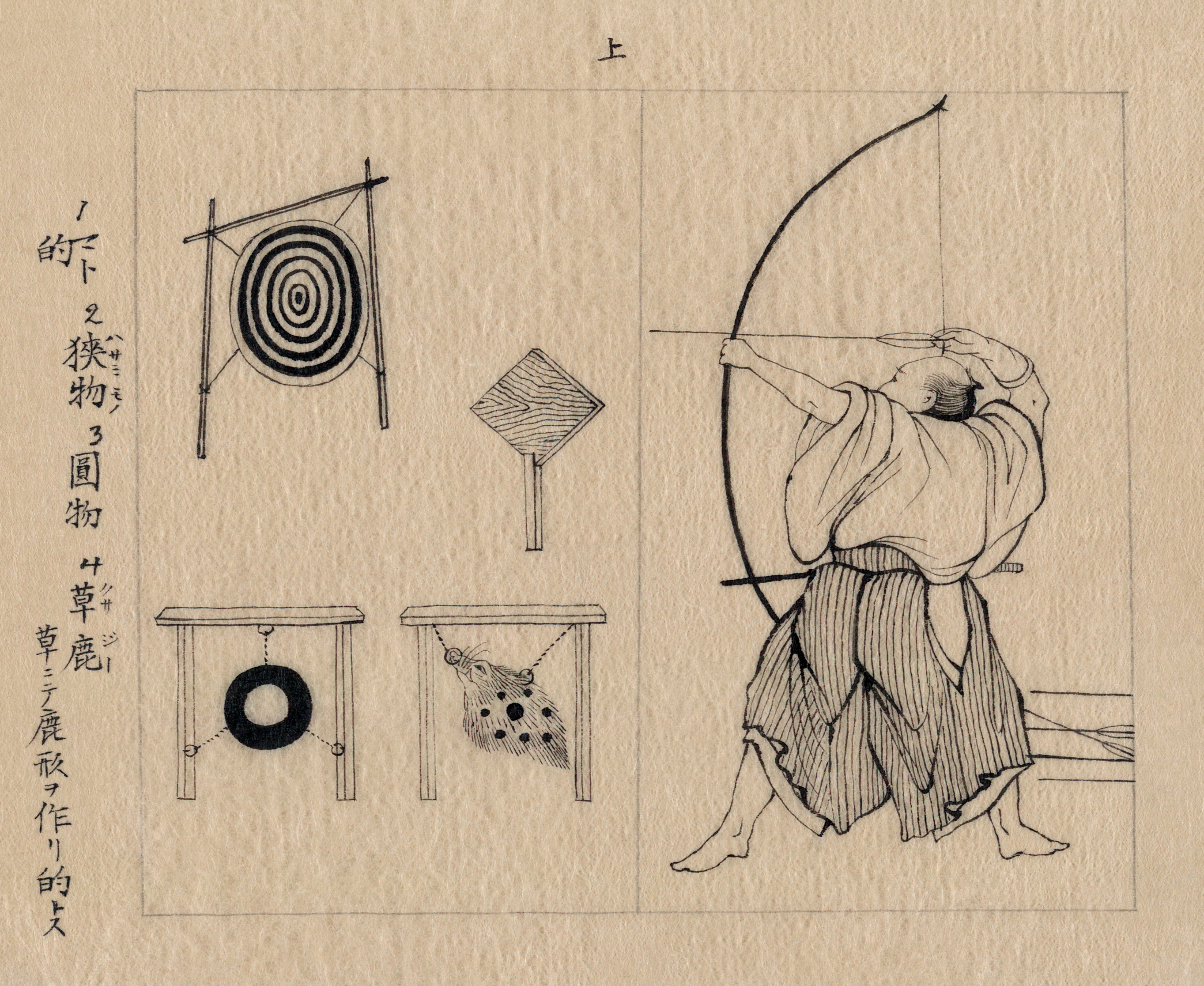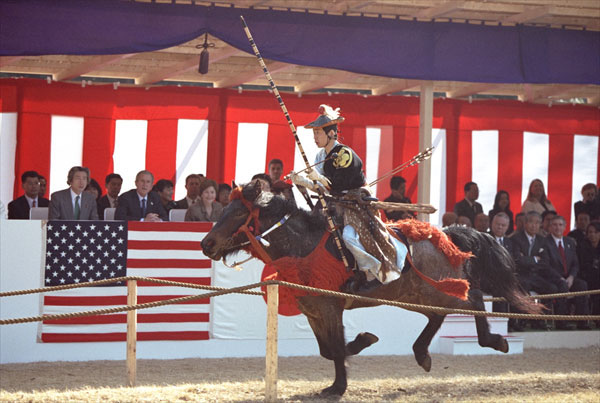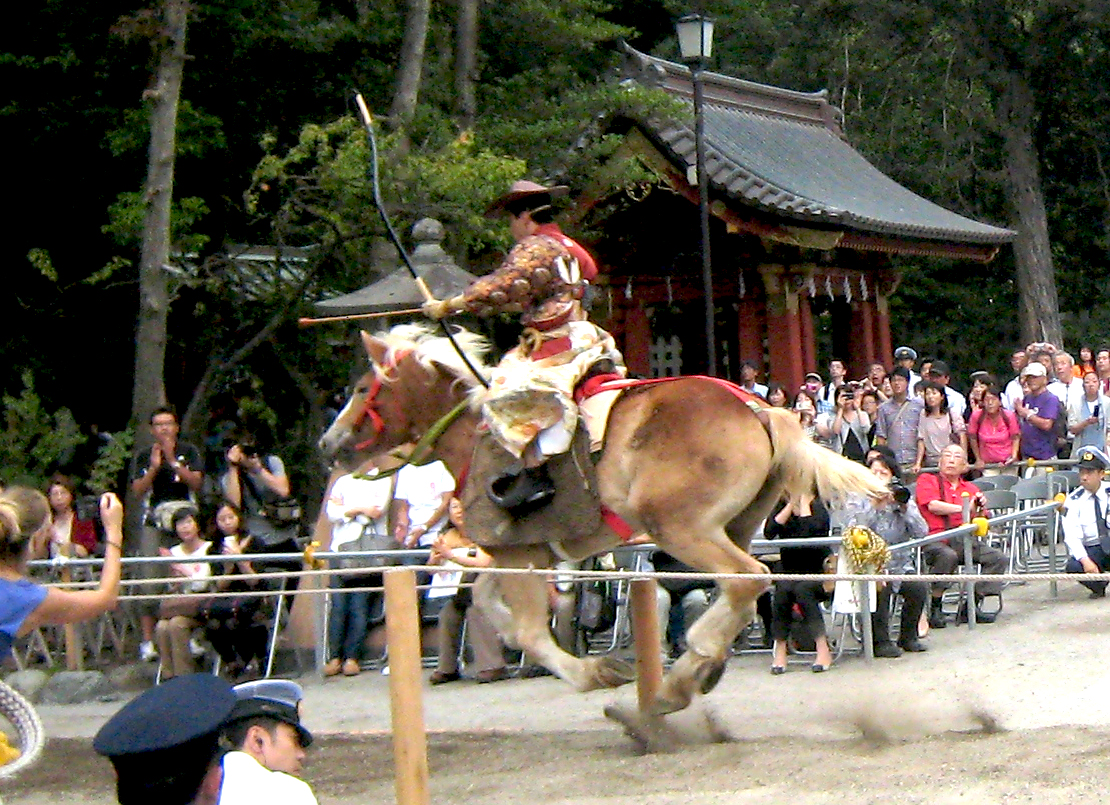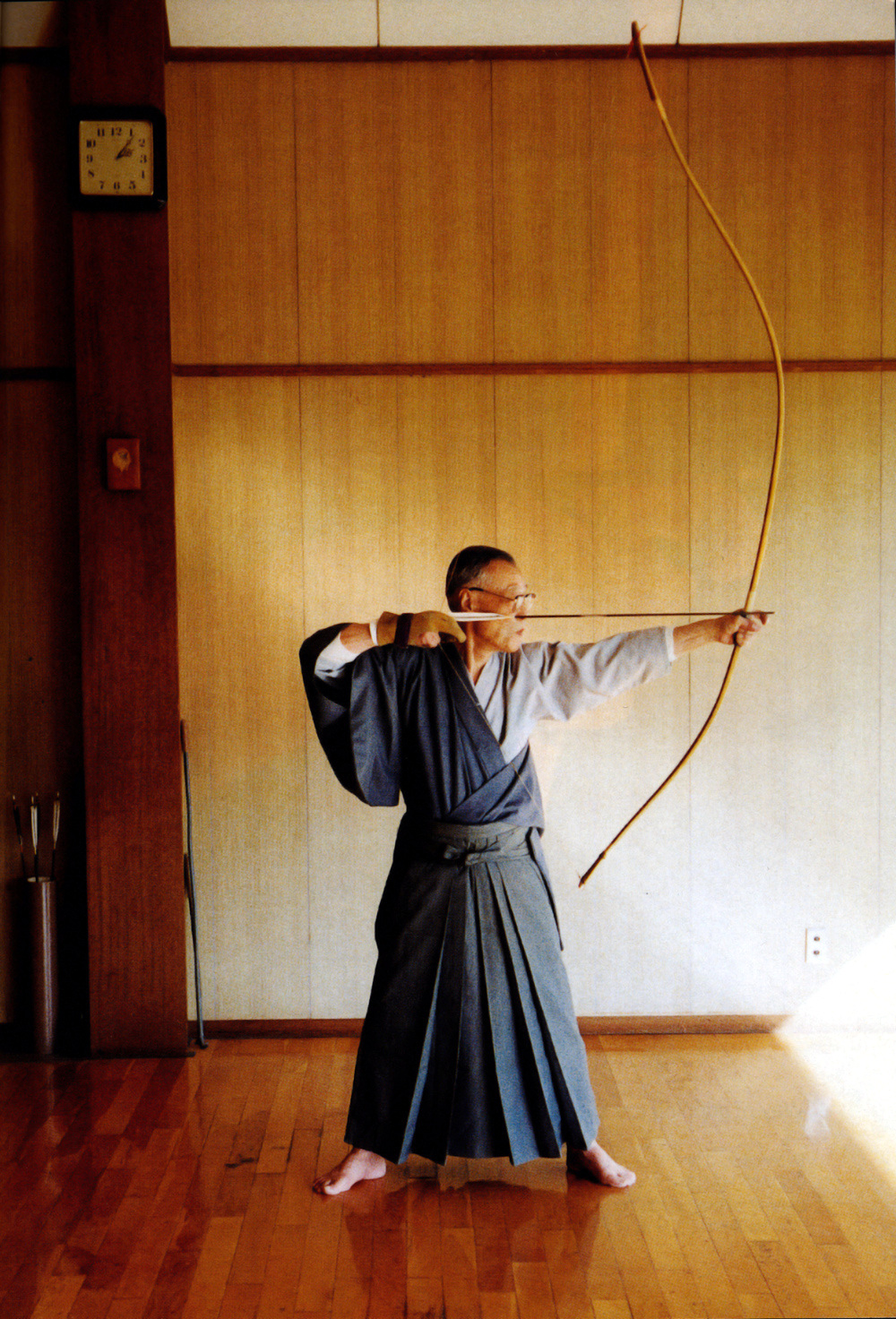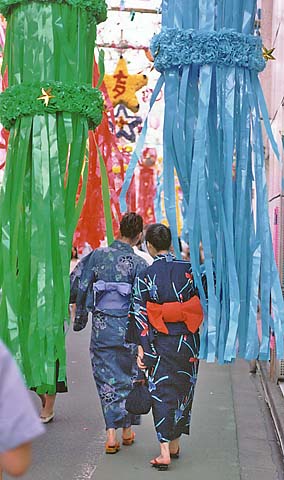|
Kasagake
Kasagake or Kasakake (ń¼ĀµćĖ, lit. "hat shooting") is a type of Japanese mounted archery. In contrast to yabusame, the types of targets are various and the archer shoots without stopping the horse. While yabusame has been played as a part of formal ceremonies, kasagake has developed as a game or practice of martial arts, focusing on technical elements of horse archery. History The word "kasagake" first appears in "Sadaie Assonn Ki" (Õ«ÜÕ«Čµ£ØĶćŻĶ©ś) by Minamoto no Sadaie in 1057 and "Shin Sarug┼Ź Ki" (µ¢░ńī┐µźĮĶ©ś) by Fujiwara no Akihira (989-1066)Murai, 1939 while legendary sayings states kasagake has been started by Minamoto no Yoritomo (1147-1199). At first, hats (ayaigasa) hung on azuchi were used as targets, later replaced by target specially made for kasagake, consists of wooden skeleton, cotton, wool or rice straws stuffing and leather surface, hung on wooden frames as in the picture above. In Kamakura period, "the three martial arts of mounted archery" (ķ©ÄÕ░äõĖēńē ... [...More Info...] [...Related Items...] OR: [Wikipedia] [Google] [Baidu] |
Kyūjutsu
("art of archery") is the traditional Japanese martial art of wielding a bow (yumi) as practiced by the samurai class of feudal Japan. Although the samurai are perhaps best known for their swordsmanship with a katana (''kenjutsu''), ky┼½jutsu was actually considered a more vital skill for a significant portion of Japanese history. During the majority of the Kamakura period through the Muromachi period (c.1185–c.1568), the bow was almost exclusively the symbol of the professional warrior, and way of life of the warrior was referred to as . History The beginning of archery in Japan is, as elsewhere, pre-historical. The first images picturing the distinct Japanese asymmetrical longbow are from the Yayoi period (ca. 500 BCŌĆō300 AD). The first written document describing Japanese archery is the Chinese chronicle ''Weishu'' (ķŁÅµøĖ; dated around 297 AD), which tells how in the Japanese isles people use "a wooden bow that is short from the bottom and long from the top."Yamada S ... [...More Info...] [...Related Items...] OR: [Wikipedia] [Google] [Baidu] |
Yabusame
is a type of mounted archery in traditional Japanese archery. An archer on a running horse shoots three special "turnip-headed" arrows successively at three wooden targets. This style of archery has its origins at the beginning of the Kamakura period. Minamoto no Yoritomo became alarmed at the lack of archery skills his samurai possessed. He organized yabusame as a form of practice. Nowadays, the best places to see yabusame performed are at the Tsurugaoka Hachiman-g┼½ in Kamakura and Shimogamo Shrine in Kyoto (during Aoi Matsuri in early May). It is also performed in Samukawa and on the beach at Zushi, as well as other locations. History Japanese bows date back to prehistoric times ŌĆō the J┼Źmon period. The long, unique asymmetrical bow style with the grip below the center emerged under the Yayoi culture (300 BC ŌĆō 300 AD). Bows became the symbol of authority and power. The legendary first emperor of Japan, Emperor Jimmu, is always depicted carrying a bow. Some Emi ... [...More Info...] [...Related Items...] OR: [Wikipedia] [Google] [Baidu] |
Yabusame 04
is a type of mounted archery in traditional Japanese archery. An archer on a running horse shoots three special "turnip-headed" arrows successively at three wooden targets. This style of archery has its origins at the beginning of the Kamakura period. Minamoto no Yoritomo became alarmed at the lack of archery skills his samurai possessed. He organized yabusame as a form of practice. Nowadays, the best places to see yabusame performed are at the Tsurugaoka Hachiman-g┼½ in Kamakura and Shimogamo Shrine in Kyoto (during Aoi Matsuri in early May). It is also performed in Samukawa and on the beach at Zushi, as well as other locations. History Japanese bows date back to prehistoric times ŌĆō the J┼Źmon period. The long, unique asymmetrical bow style with the grip below the center emerged under the Yayoi culture (300 BC ŌĆō 300 AD). Bows became the symbol of authority and power. The legendary first emperor of Japan, Emperor Jimmu, is always depicted carrying a bow. Some Emi ... [...More Info...] [...Related Items...] OR: [Wikipedia] [Google] [Baidu] |
Mounted Archery
A horse archer is a cavalryman armed with a bow and able to shoot while riding from horseback. Archery has occasionally been used from the backs of other riding animals. In large open areas, it was a highly successful technique for hunting, for protecting the herds, and for war. It was a defining characteristic of the Eurasian nomads during antiquity and the medieval period, as well as the Iranian peoples, (Alans, Scythians, Sarmatians, Parthians, Sassanid Persians) and Indians in antiquity, and by the Hungarians, Mongols, Chinese, and the Turkic peoples during the Middle Ages. By the expansion of these peoples, the practice also spread to Eastern Europe (via the Sarmatians and the Huns), Mesopotamia, and East Asia. In East Asia, horse archery came to be particularly honored in the samurai tradition of Japan, where horse archery is called Yabusame. The term mounted archer occurs in medieval English sources to describe a soldier who rode to battle but who dismounted to shoot. ' ... [...More Info...] [...Related Items...] OR: [Wikipedia] [Google] [Baidu] |
Inuoumono
was a Japanese sport that involved mounted archers shooting at dogs. The dogs were released into a circular enclosure approximately 15m across, and mounted archers would fire upon them whilst riding around the perimeter. Originally intended as a military training exercise, dog-shooting became popular as a sport among the Japanese nobility during the Kamakura and Muromachi periods (1185-1573). During this time it was briefly banned during the rule of Emperor Go-Daigo (owing to his concern for the dogs); however, this ruling was overturned by the sh┼Źgun Ashikaga Takauji at the behest of his archery teacher Ogasawara Sadamune. The influential Ogasawara family were particular adherents of inuoumono; Sadamune's archery treatise ''Inuoumono mikuanbumi'' regarded it as fundamental to a warrior's training, and his great-grandson Mochinaga devoted five books to the subject. The arrows used in dog-shooting were usually rendered non-fatal, by being either padded or blunted. This modificati ... [...More Info...] [...Related Items...] OR: [Wikipedia] [Google] [Baidu] |
Ky┼½d┼Ź
''Ky┼½d┼Ź'' ( ja, Õ╝ōķüō) is the Japanese martial art of archery. Ky┼½d┼Ź is based on '' ky┼½jutsu'' ("art of archery"), which originated with the samurai class of feudal Japan. In 1919, the name of ky┼½jutsu was officially changed to ky┼½d┼Ź, and following the example of other martial arts that have been systematizing for educational purposes, ky┼½d┼Ź also reorganized and integrated various forms of shooting that had been used up until then. High level experts in ky┼½d┼Ź may be referred to as , and some practitioners may refer to themselves as ''yumihiki'' (Õ╝ōÕ╝ĢŃüŹ), or 'bow puller'. Ky┼½d┼Ź is practised by thousands of people worldwide. As of 2005, the International Kyudo Federation had 132,760 graded members. The bow they use is called a , and the most common one has an asymmetrical shape of more than , and is characterized by the archer holding the part of the bow below the center to shoot the arrow. History The beginning of archery in Japan is pre-historical. The first ... [...More Info...] [...Related Items...] OR: [Wikipedia] [Google] [Baidu] |
Yabusame
is a type of mounted archery in traditional Japanese archery. An archer on a running horse shoots three special "turnip-headed" arrows successively at three wooden targets. This style of archery has its origins at the beginning of the Kamakura period. Minamoto no Yoritomo became alarmed at the lack of archery skills his samurai possessed. He organized yabusame as a form of practice. Nowadays, the best places to see yabusame performed are at the Tsurugaoka Hachiman-g┼½ in Kamakura and Shimogamo Shrine in Kyoto (during Aoi Matsuri in early May). It is also performed in Samukawa and on the beach at Zushi, as well as other locations. History Japanese bows date back to prehistoric times ŌĆō the J┼Źmon period. The long, unique asymmetrical bow style with the grip below the center emerged under the Yayoi culture (300 BC ŌĆō 300 AD). Bows became the symbol of authority and power. The legendary first emperor of Japan, Emperor Jimmu, is always depicted carrying a bow. Some Emi ... [...More Info...] [...Related Items...] OR: [Wikipedia] [Google] [Baidu] |
Ky┼½d┼Ź
''Ky┼½d┼Ź'' ( ja, Õ╝ōķüō) is the Japanese martial art of archery. Ky┼½d┼Ź is based on '' ky┼½jutsu'' ("art of archery"), which originated with the samurai class of feudal Japan. In 1919, the name of ky┼½jutsu was officially changed to ky┼½d┼Ź, and following the example of other martial arts that have been systematizing for educational purposes, ky┼½d┼Ź also reorganized and integrated various forms of shooting that had been used up until then. High level experts in ky┼½d┼Ź may be referred to as , and some practitioners may refer to themselves as ''yumihiki'' (Õ╝ōÕ╝ĢŃüŹ), or 'bow puller'. Ky┼½d┼Ź is practised by thousands of people worldwide. As of 2005, the International Kyudo Federation had 132,760 graded members. The bow they use is called a , and the most common one has an asymmetrical shape of more than , and is characterized by the archer holding the part of the bow below the center to shoot the arrow. History The beginning of archery in Japan is pre-historical. The first ... [...More Info...] [...Related Items...] OR: [Wikipedia] [Google] [Baidu] |
Tanabata
, also known as the Star Festival ( µś¤ńźŁŃéŖ, ''Hoshimatsuri''), is a Japanese festival originating from the Chinese Qixi Festival. It celebrates the meeting of the deities Orihime and Hikoboshi (represented by the stars Vega and Altair respectively). According to legend, the Milky Way separates these lovers, and they are allowed to meet only once a year on the seventh day of the seventh lunar month of the lunisolar calendar. The date of Tanabata varies by region of the country, but the first festivities begin on 7 July of the Gregorian calendar. The celebration is held at various days between July and August. History The festival was introduced to Japan by the Empress K┼Źken in 755. It originated from , an alternative name for Qixi which is celebrated in China and also was adopted in the Kyoto Imperial Palace from the Heian period. The festival gained widespread popularity amongst the general public by the early Edo period, when it became mixed with various Obon or Bon t ... [...More Info...] [...Related Items...] OR: [Wikipedia] [Google] [Baidu] |
Hojo Tokimune
Hojo or H┼Źj┼Ź may refer to: Hojo or HoJo: *Howard Johnson's, a U.S. chain of restaurants and hotels *A nickname for Howard Johnson *A nickname for Howard Jones *A nickname for Howard Jones *MGR-1 Honest John, the first nuclear-capable missile and a popular airframe for hobby modelers *Hojo, a supporting character in comic strip ''Mandrake the Magician'' *Professor Hojo, a non-playable character in the video game ''Final Fantasy VII'' H┼Źj┼Ź or Houjou: * H┼Źj┼Ź clan, a family of regents of the Kamakura Shogunate *Late H┼Źj┼Ź clan, daimy┼Ź in the Sengoku Period *H┼Źj┼Ź, Ehime, a city in Japan * H┼Źj┼Ź, one of the five kata of Kashima Shinden Jikishinkage-ry┼½ *H┼Źj┼Ź, Tottori, a town in Japan (part of Hokuei) *H┼Źj┼Ź Tokiyuki (Scouting) (1858ŌĆō1929), early Japanese Scouting notable *H┼Źj┼Ź (Inuyasha), a character in the manga and anime series ''Inuyasha'' * H┼Źj┼Ź Tsukasa (popularly but incorrectly romanized "Hojo", born 1959), manga artist and creator of ''City Hunter'' * Sat ... [...More Info...] [...Related Items...] OR: [Wikipedia] [Google] [Baidu] |

